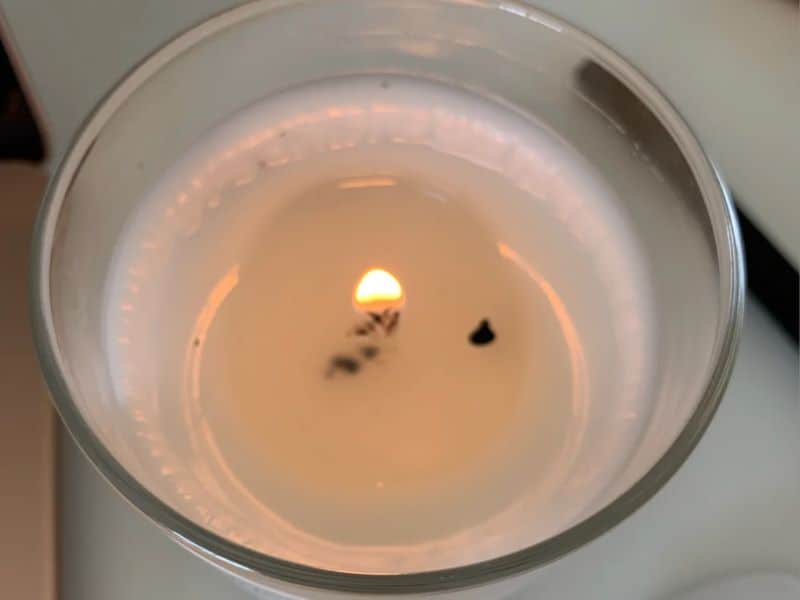When lighting scented candles, fragrance is only part of the experience. Another major part of that experience is the warm glow generated by the candle flame. When the flame is too small, it makes the experience less gratifying.
Small candle flames are usually the result of too little wax. You may also notice a small flame when your candle is nearing its end because it’s not getting enough oxygen to continue to burn.
Keep reading to learn how to address this matter so that your candles can burn bright.

What Causes a Candle Flame to be Too Small?
There are a number of factors that impact a candle’s flame height. The extent to which you can remedy the issue depends on whether you’re lighting candles you’ve purchased, or if you’re making the candles yourself. I’ve listed some troubleshooting tips for both scenarios below.
Wick Length Too Short
One common reason is that the wick itself is too short. Sometimes, when maintaining candles for a clean burning experience, we might cut the wick too short.
The next time you light the candle, you might notice that the flame is really low. It’s unable to generate enough heat to melt the wax round it. This can happen sometimes, and there’s an easy fix.
- You can light the candle and allow a small pool of wax to form around the wick for about twenty minutes or so.
- Once you see a nice pool of wax, blow out the candle. Don’t worry about tunneling, you’ll relight it shortly. Take a cotton ball and soak up the liquid wax. You can also use a paper towel or cotton swab. Pouring the wax onto something you can dispose of is another option. But I think that soaking it up is less messy. Keep in mind that the wax will be warm to the touch, so be careful.
- I’d then place the cotton swab on a disposable napkin and allow it to cool before throwing it away.
- Next, relight the candle. At this point more of the wick should be visible. You can light it to see if the flame is at its normal height (no more than 2 inches tall).
Tunneling
If your candle repeatedly hasn’t burned until it creates a full wax pool, then you will likely experience tunneling. This is when your wick appears to be at the bottom of a tunnel because a thick wall of wax has built up on the sides of the container.
In situations like this, the flame is small because it doesn’t have access to as much oxygen. Both wax and oxygen are necessary to keep the flame going. When there is little oxygen, the flame gets smaller and smaller. And it becomes increasingly more difficult to even access the wick.
To correct this, you can try a couple things. First, make sure to remove any debris that might have fallen into the tunnel. Also straighten out your wick, pulling it up as best you can.
Tunneling Reversal Method 1
- Fill a cooking pot with cool or room temperature water. You want enough to reach about three-fourths of your candle. But you don’t want any water to enter into the candle container.
- Place the candle container in the pot filled with water.
- Turn on low heat to gently warm the container until you see the wax melting.
- This process should even out the wax pool. Keep an eye on the wick to make sure it doesn’t get buried. Use a butter knife or popsicle stick to straighten the wick as needed.
- Turn the heat off once the wax has melted and there’s a sufficient wax pool.
At this point, allow the wax to cool before lighting the candle. This might actually take a day or two because melting the wax this way is almost like making a candle all over again. Be patient, otherwise all your work would have been for nothing.
If you remove the container from the water, it will be hot, so be sure to use an oven mitt. Otherwise, you can allow the container to sit in the water until both it and the water have reached a more bearable temperature.
Once it’s fully hardened, your flame should rise as normal. Just be sure to always allow for a full pool of wax to form before blowing out your candle going forward.
Tunneling Reversal Method 2
Another option is to heat the wax using a blow dryer. Also called a hair dryer, you will want to be safe using this method as well.
- Holding the dryer over the container, apply the heat in circular motion until the wax pools. Keep an eye on the wick so that it doesn’t sink into the liquid wax.
- Once all of the wax on the sides of the container has melted, you can turn off the blow dryer.
- Allow the wax to reharden for a few days before lighting the candle.
Insufficient Oxygen
Sometimes we love a candle fragrance so much that once it reaches the bottom, we don’t want to let it go. It can be difficult to stop lighting candles when wax remains.
But the flame will be small because it has access to less oxygen at the bottom of the container. Far less of the wick remains, making it nearly impossible for melted wax to fuel the flame.
At this point, it’s safer to just extinguish the flame and accept that you can’t light it again. If your candle container has a shallow bottom, it can even be dangerous to continue trying to light a candle until all the wax is gone.
Instead, you can explore many different ways to repurpose that wax and even the container.
Burning Multiple Wicks
Some wider candles are made with multiple wicks. This prevents tunneling and leads to an even wax pool so long as the candle is burned properly.
But burning three wicks at once means that they’re all fighting for the same wax and oxygen. Since both have to be distributed amongst three wicks, the flame might not burn as high.
In this case, there isn’t anything that you can do but accept that the flames might not be as high as you’d like.
Troubleshooting Tip for Candle Makers
The remaining tip is for those who make candles and notice a small flame during the testing process.
Underwicked Candle
If you select a wick that is too small for the container that it’s in, then it will not burn properly. When a wick is too thin or small for the container, it will not pool to the edges.
The wick isn’t absorbing enough wax to generate sufficient heat to keep the flame going. Thus, the wax only liqufies in the center of the container and eventually the flame gets so small that it burns out on its own. It drowns in the pool of wax.
You or your customers will experience tunneling. Although tunneling can be fixed, it’s best avoided for a positive candle lighting experience.
To remedy this, you’ll have to do more research about selecting the proper wick for your container and wax type. You may have to test multiple sizes in order to find one that isn’t under or overwicked.
In Conclusion
Having a candle flame that burns too small can be annoying. In most cases, though, there’s a remedy.
You can properly care for your wick, avoid tunneling, and accept it when it’s time to simply refrain from burning candles with little remaining wax.
If you’re a candle maker, take the time to choose the best wick for your container.
Read more:
